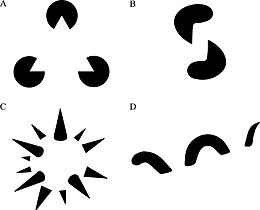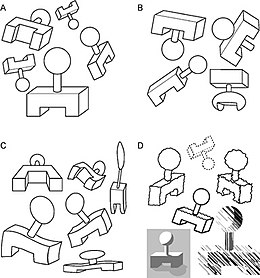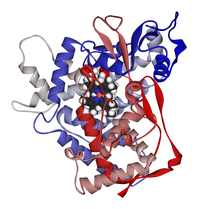Quantum cognition is an emerging field which applies the mathematical formalism of quantum theory to model cognitive phenomena such as information processing by the human brain, language, decision making, human memory, concepts and conceptual reasoning, human judgment, and perception. The field clearly distinguishes itself from the quantum mind
as it is not reliant on the hypothesis that there is something
micro-physical quantum mechanical about the brain. Quantum cognition is
based on the quantum-like paradigm or generalized quantum paradigm or quantum structure paradigm
that information processing by complex systems such as the brain,
taking into account contextual dependence of information and
probabilistic reasoning, can be mathematically described in the
framework of quantum information and quantum probability theory.
Quantum cognition uses the mathematical formalism of quantum theory to inspire and formalize models of cognition that aim to be an advance over models based on traditional classical probability theory. The field focuses on modeling phenomena in cognitive science that have resisted traditional techniques or where traditional models seem to have reached a barrier (e.g., human memory), and modeling preferences in decision theory that seem paradoxical from a traditional rational point of view (e.g., preference reversals). Since the use of a quantum-theoretic framework is for modeling purposes, the identification of quantum structures in cognitive phenomena does not presuppose the existence of microscopic quantum processes in the human brain.
Quantum cognition uses the mathematical formalism of quantum theory to inspire and formalize models of cognition that aim to be an advance over models based on traditional classical probability theory. The field focuses on modeling phenomena in cognitive science that have resisted traditional techniques or where traditional models seem to have reached a barrier (e.g., human memory), and modeling preferences in decision theory that seem paradoxical from a traditional rational point of view (e.g., preference reversals). Since the use of a quantum-theoretic framework is for modeling purposes, the identification of quantum structures in cognitive phenomena does not presuppose the existence of microscopic quantum processes in the human brain.
Main subjects of research
Quantum-like models of information processing ("quantum-like brain")
The
brain is definitely a macroscopic physical system operating on the
scales (of time, space, temperature) which differ crucially from the
corresponding quantum scales. (The macroscopic quantum physical
phenomena such as e.g. the Bose-Einstein condensate are also
characterized by the special conditions which are definitely not
fulfilled in the brain.) In particular, the brain is simply too hot to
be able perform the real quantum information processing, i.e., to use
the quantum carriers of information such as photons, ions, electrons. As
is commonly accepted in brain science, the basic unit of information
processing is a neuron. It is clear that a neuron cannot be in the
superposition of two states: firing and non-firing. Hence, it cannot
produce superposition playing the basic role in the quantum information
processing. Superpositions of mental states are created by complex
networks of neurons (and these are classical neural networks). Quantum
cognition community states that the activity of such neural networks can
produce effects which are formally described as interference (of
probabilities) and entanglement. In principle, the community does not
try to create the concrete models of quantum (-like) representation of
information in the brain.
The quantum cognition project is based on the observation that
various cognitive phenomena are more adequately described by quantum
information theory and quantum probability than by the corresponding
classical theories, see examples below. Thus the quantum formalism is
considered as an operational formalism describing nonclassical
processing of probabilistic data. Recent derivations of the complete
quantum formalism from simple operational principles for representation
of information supports the foundations of quantum cognition. The
subjective probability viewpoint on quantum probability which was
developed by C. Fuchs and collaborators
also supports the quantum cognition approach, especially using of
quantum probabilities to describe the process of decision making.
Although at the moment we cannot present the concrete
neurophysiological mechanisms of creation of the quantum-like
representation of information in the brain,
we can present general informational considerations supporting the idea
that information processing in the brain matches with quantum
information and probability. Here, contextuality is the key word, see
the monograph of Khrennikov for detailed representation of this viewpoint. Quantum mechanics is fundamentally contextual.
Quantum systems do not have objective properties which can be defined
independently of measurement context. (As was pointed by N. Bohr, the
whole experimental arrangement must be taken into account.)
Contextuality implies existence of incompatible mental variables,
violation of the classical law of total probability and (constructive
and destructive) interference effects. Thus the quantum cognition
approach can be considered as an attempt to formalize contextuality of
mental processes by using the mathematical apparatus of quantum
mechanics.
Decision making
Suppose
a person is given an opportunity to play two rounds of the following
gamble: a coin toss will determine whether the subject wins $200 or
loses $100. Suppose the subject has decided to play the first round, and
does so. Some subjects are then given the result (win or lose) of the
first round, while other subjects are not yet given any information
about the results. The experimenter then asks whether the subject wishes
to play the second round. Performing this experiment with real subjects
gives the following results:
- When subjects believe they won the first round, the majority of subjects choose to play again on the second round.
- When subjects believe they lost the first round, the majority of subjects choose to play again on the second round.
Given these two separate choices, according to the sure thing
principle of rational decision theory, they should also play the second
round even if they don't know or think about the outcome of the first
round.
But, experimentally, when subjects are not told the results of the first
round, the majority of them decline to play a second round.
This finding violates the law of total probability, yet it can be explained as a quantum interference effect in a manner similar to the explanation for the results from double-slit experiment in quantum physics. Similar violations of the sure-thing principle are seen in empirical studies of the Prisoner's Dilemma and have likewise been modeled in terms of quantum interference.
The above deviations from classical rational expectations in
agents’ decisions under uncertainty produce well known paradoxes in
behavioral economics, that is, the Allais, Ellsberg and Machina paradoxes.
These deviations can be explained if one assumes that the overall
conceptual landscape influences the subject's choice in a neither
predictable nor controllable way. A decision process is thus an
intrinsically contextual process, hence it cannot be modeled in a single
Kolmogorovian probability space, which justifies the employment of
quantum probability models in decision theory. More explicitly, the
paradoxical situations above can be represented in a unified Hilbert
space formalism where human behavior under uncertainty is explained in
terms of genuine quantum aspects, namely, superposition, interference,
contextuality and incompatibility.
Considering automated decision making, quantum decision trees
have different structure compared to classical decision trees. Data can
be analyzed to see if a quantum decision tree model fits the data
better.
Human probability judgments
Quantum
probability provides a new way to explain human probability judgment
errors including the conjunction and disjunction errors. A conjunction error occurs when a person judges the probability of a likely event L and
an unlikely event U to be greater than the unlikely event U; a
disjunction error occurs when a person judges the probability of a
likely event L to be greater than the probability of the likely event L or an unlikely event U. Quantum probability theory is a generalization of Bayesian probability theory because it is based on a set of von Neumann axioms that relax some of the classic Kolmogorov axioms.
The quantum model introduces a new fundamental concept to cognition—the
compatibility versus incompatibility of questions and the effect this
can have on the sequential order of judgments. Quantum probability
provides a simple account of conjunction and disjunction errors as well
as many other findings such as order effects on probability judgments.
The liar paradox - The contextual influence of a human subject on
the truth behavior of a cognitive entity is explicitly exhibited by the
so-called liar paradox,
that is, the truth value of a sentence like "this sentence is false".
One can show that the true-false state of this paradox is represented in
a complex Hilbert space, while the typical oscillations between true
and false are dynamically described by the Schrödinger equation.
Knowledge representation
Concepts are basic cognitive phenomena, which provide the content for inference, explanation, and language understanding. Cognitive psychology has researched different approaches for understanding concepts including exemplars, prototypes, and neural networks,
and different fundamental problems have been identified, such as the
experimentally tested non classical behavior for the conjunction and
disjunction of concepts, more specifically the Pet-Fish problem or guppy
effect, and the overextension and underextension of typicality and membership weight for conjunction and disjunction. By and large, quantum cognition has drawn on quantum theory in three ways to model concepts.
- Exploit the contextuality of quantum theory to account for the contextuality of concepts in cognition and language and the phenomenon of emergent properties when concepts combine
- Use quantum entanglement to model the semantics of concept combinations in a non-decompositional way, and to account for the emergent properties/associates/inferences in relation to concept combinations
- Use quantum superposition to account for the emergence of a new concept when concepts are combined, and as a consequence put forward an explanatory model for the Pet-Fish problem situation, and the overextension and underextension of membership weights for the conjunction and disjunction of concepts.
The large amount of data collected by Hampton
on the combination of two concepts can be modeled in a specific
quantum-theoretic framework in Fock space where the observed deviations
from classical set (fuzzy set) theory, the above-mentioned over- and
under- extension of membership weights, are explained in terms of
contextual interactions, superposition, interference, entanglement and
emergence.
And, more, a cognitive test on a specific concept combination has been
performed which directly reveals, through the violation of Bell's
inequalities, quantum entanglement between the component concepts.
Human memory
The
hypothesis that there may be something quantum-like about the human
mental function was put forward with the quantum entanglement formula
which attempted to model the effect that when a word's associative
network is activated during study in memory experiment, it behaves like a
quantum-entangled system. Models of cognitive agents and memory based on quantum collectives have been proposed by Subhash Kak.
But he also points to specific problems of limits on observation and
control of these memories due to fundamental logical reasons.
Semantic analysis and information retrieval
The
research in (iv) had a deep impact on the understanding and initial
development of a formalism to obtain semantic information when dealing
with concepts, their combinations and variable contexts in a corpus of
unstructured documents. This conundrum of natural language processing (NLP) and information retrieval
(IR) on the web – and data bases in general – can be addressed using
the mathematical formalism of quantum theory. As basic steps, (a) the
seminal book "The Geometry of Information Retrieval" by K. Van
Rijsbergen
introduced a quantum structure approach to IR, (b) Widdows and Peters
utilised a quantum logical negation for a concrete search system, and Aerts and Czachor identified quantum structure in semantic space theories, such as latent semantic analysis.
Since then, the employment of techniques and procedures induced from
the mathematical formalisms of quantum theory – Hilbert space, quantum
logic and probability, non-commutative algebras, etc. – in fields such
as IR and NLP, has produced significant results.
Human perception
Bi-stable
perceptual phenomena is a fascinating topic in the area of perception.
If a stimulus has an ambiguous interpretation, such as a Necker cube,
the interpretation tends to oscillate across time. Quantum models have
been developed to predict the time period between oscillations and how
these periods change with frequency of measurement.
Quantum theory and an appropriate model have been developed by Elio
Conte to account for interference effects obtained with measurements of
ambiguous figures.
There are apparent similarities between Gestalt perception and quantum theory. In an article discussing the application of Gestalt to chemistry, Anton Amann writes: "Quantum mechanics does not
explain Gestalt perception, of course, but in quantum mechanics and
Gestalt psychology there exist almost isomorphic conceptions and
problems:
- Similarly as with the Gestalt concept, the shape of a quantum object does not a priori exist but it depends on the interaction of this quantum object with the environment (for example: an observer or a measurement apparatus).
- Quantum mechanics and Gestalt perception are organized in a holistic way. Subentities do not necessarily exist in a distinct, individual sense.
- In quantum mechanics and Gestalt perception objects have to be created by elimination of holistic correlations with the 'rest of the world'."
Each of the points mentioned in the above text in a simplified manner
(Below explanations correlate respectively with the above-mentioned
points):
- As an object in quantum physics doesn't have any shape until and unless it interacts with its environment; Objects according to Gestalt perspective do not hold much of a meaning individually as they do when there is a "group" of them or when they are present in an environment.
- Both in quantum mechanics and Gestalt perception, the objects must be studied as a whole rather than finding properties of individual components and interpolating the whole object.
- In Gestalt concept creation of a new object from another previously existing object means that the previously existing object now becomes a sub entity of the new object, and hence "elimination of holistic correlations" occurs. Similarly a new quantum object made from a previously existing object means that the previously existing object looses its holistic view.
Amann comments: "The structural similarities between Gestalt
perception and quantum mechanics are on a level of a parable, but even
parables can teach us something, for example, that quantum mechanics is
more than just production of numerical results or that the Gestalt
concept is more than just a silly idea, incompatible with atomistic
conceptions."[60]
Quantum-like models of cognition in economics and finance
The
assumption that information processing by the agents of the market
follows the laws of quantum information theory and quantum probability
was actively explored by many authors, e.g., E. Haven, O. Choustova, A.
Khrennikov, see the book of E. Haven and A. Khrennikov,[61]
for detailed bibliography. We can mention, e.g., the Bohmian model of
dynamics of prices of shares in which the quantum(-like) potential is
generated by expectations of agents of the financial market and, hence,
it has the mental nature. This approach can be used to model real
financial data, see the book of E. Haven and A. Khrennikov (2012).
Application of theory of open quantum systems to decision making and "cell's cognition"
An
isolated quantum system is an idealized theoretical entity. In reality
interactions with environment have to be taken into account. This is the
subject of theory of open quantum systems. Cognition is also
fundamentally contextual. The brain is a kind of (self-)observer which
makes context dependent decisions. Mental environment plays a crucial
role in information processing. Therefore, it is natural to apply theory
of open quantum systems to describe the process of decision making as
the result of quantum-like dynamics of the mental state of a system
interacting with an environment. The description of the process of
decision making is mathematically equivalent to the description of the
process of decoherence. This idea was explored in a series of works of
the multidisciplinary group of researchers at Tokyo University of
Science.[62][63]
Since in the quantum-like approach the formalism of quantum
mechanics is considered as a purely operational formalism, it can be
applied to the description of information processing by any biological
system, i.e., not only by human beings.
Operationally it is very convenient to consider e.g. a cell as a
kind of decision maker processing information in the quantum information
framework. This idea was explored in a series of papers of the
Swedish-Japanese research group using the methods of theory of open
quantum systems: genes expressions were modeled as decision making in
the process of interaction with environment.[64]
History
Here is a short history of applying the formalisms of quantum theory to topics in psychology. Ideas for applying quantum formalisms to cognition first appeared in the 1990s by Diederik Aerts and his collaborators Jan Broekaert, Sonja Smets and Liane Gabora, by Harald Atmanspacher, Robert Bordley, and Andrei Khrennikov. A special issue on Quantum Cognition and Decision appeared in the Journal of Mathematical Psychology
(2009, vol 53.), which planted a flag for the field. A few books
related to quantum cognition have been published including those by
Khrennikov (2004, 2010), Ivancivic and Ivancivic (2010), Busemeyer and
Bruza (2012), E. Conte (2012). The first Quantum Interaction workshop
was held at Stanford in 2007 organized by Peter Bruza, William Lawless, C. J. van Rijsbergen, and Don Sofge as part of the 2007 AAAI Spring Symposium Series. This was followed by workshops at Oxford in 2008, Saarbrücken in 2009, at the 2010 AAAI Fall Symposium Series held in Washington, D.C., 2011 in Aberdeen, 2012 in Paris, and 2013 in Leicester. Tutorials also were presented annually beginning in 2007 until 2013 at the annual meeting of the Cognitive Science Society. A Special Issue on Quantum models of Cognition appeared in 2013 in the journal Topics in Cognitive Science.
Related theories
It was suggested by theoretical physicists David Bohm and Basil Hiley that mind and matter both emerge from an "implicate order".[65] Bohm and Hiley's approach to mind and matter is supported by philosopher Paavo Pylkkänen.[66]
Pylkkänen underlines "unpredictable, uncontrollable, indivisible and
non-logical" features of conscious thought and draws parallels to a
philosophical movement some call "post-phenomenology", in particular to Pauli Pylkkö's notion of the "aconceptual experience", an unstructured, unarticulated and pre-logical experience.[67]
The mathematical techniques of both Conte's group and Hiley's group involve the use of Clifford algebras. These algebras account for "non-commutativity" of thought processes (for an example, see: noncommutative operations in everyday life).
This section has multiple issues. Please help improve it or discuss these issues on the talk page. (Learn how and when to remove these template messages)
|
However, an area that needs to be investigated is the concept
lateralised brain functioning. Some studies in marketing have related
lateral influences on cognition and emotion in processing of attachment
related stimuli.













